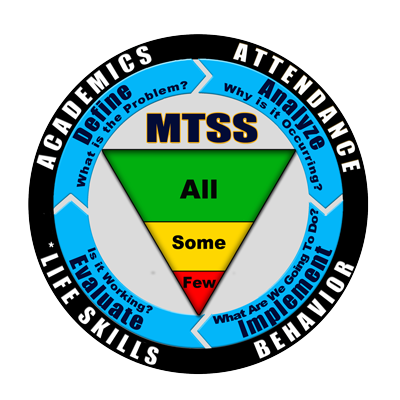MTSS
-
Multi-Tiered System of Supports (MTSS) refers to the continuum of evidence-based instructional strategies, interventions, supports and resources that are used to rapidly respond to students' academic and behavior needs using a problem solving process.
An effective school-based MTSS includes: leadership, building capacity, communication and collaboration, problem solving, multiple tiers of instruction and intervention, and data evaluation.

-
Leadership
The Principal and Instructional Leadership Team (ILT) are critical to implementing MTSS at the school level. The ILT is a multi-disciplinary team of professionals who create and support a structure for school-based decision making, establish and monitor school-wide learning and development goals, ensure and coordinate the delivery of services to all students, allocate the resources needed to fully implement plans with fidelity, and monitor the effectiveness of instruction, intervention and support.
Building Capacity
Capacity building includes involving key people and leaders, building the school culture to support the practice, working to infuse problem-solving and data-based decision making into ongoing structures, such as faculty meetings, grade and content area meetings, curriculum committees and Teacher Collaborative Teams (TCT), and making use of student data to inform actions and expectations for all staff.
Communication & Collaboration
Ongoing communication and collaboration are essential for successful implementation of MTSS. It is also important to build the infrastructure to communicate and work with families and other community partners. These practices increase the likelihood that innovative practices will be implemented and sustained.
Problem Solving Process
Problem solving is the practice of providing high-quality instruction and intervention matched to student needs and using learning rate over time and level of performance to make important educational decisions (Batsche, et al., 2005).
Multiple Tiers of Instruction & Intervention
Tiers of instruction and intervention are provided per each student’s need, ensure that each student may master grade and age appropriate standards and expectations, ensure that each student may progress successfully (on time, age appropriately) through the K-12 system.
Data Evaluation
Policies and procedures for decision-making are established that include schedules for screening, the use of diagnostic assessments, frequent progress monitoring, and the criteria for determining tiers of support needed. Staff also administer assessments, access data sources and make data-based decisions with fidelity to the policies and procedures established by the leadership team.


